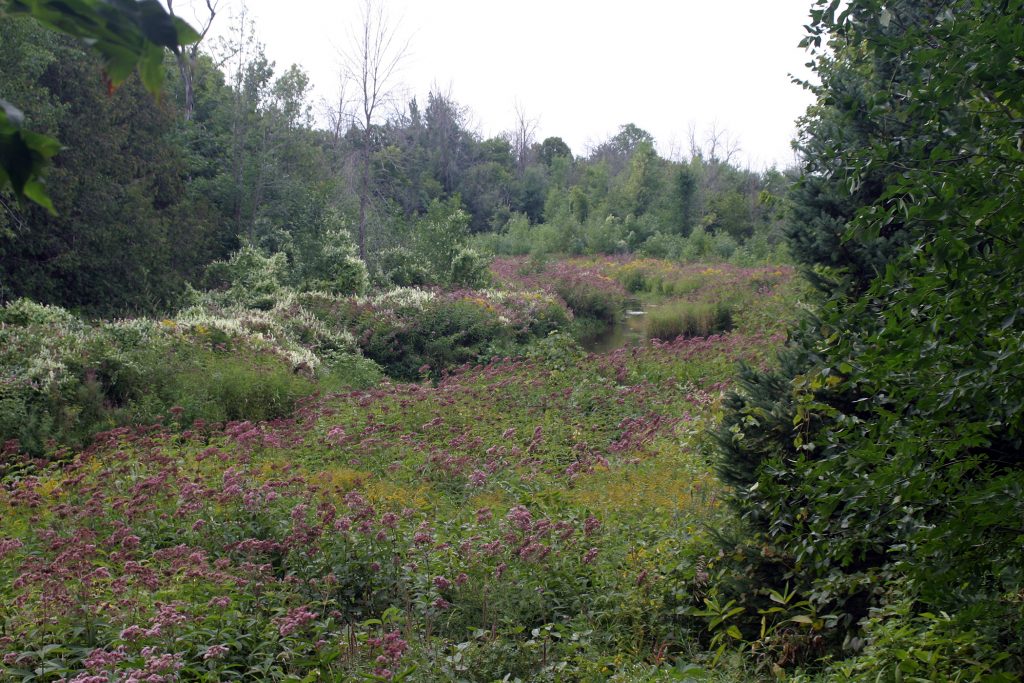Carp cement plant fight continues
CARP – The Huntley Creek redfin babies have been growing strong since the May spawning season and will soon begin their migration to deeper waters before winter’s icy grip reaches the creek.
They will travel down Huntley Creek to the Carp River and from there, to the Ottawa River where they will stay and grow.
It could be 10 years before they return to Huntley Creek to produce their own young in the never-ending cycle of life. A group of Carp residents opposed to a proposed Cavanagh Construction cement batching plant planned to be built adjacent to the creek say the project will mean the end of the redfin spawning ground.
“The city has washed its hands of the environmental impact,” Ron Grabe told West Carleton Online from Huntley Creek neighbour Dan Mayo’s home, Swallow Creek Farm, on Oak Creek Road Tuesday, Aug. 27.
Ron, his wife Lynn and Mayo sat down with West Carleton Online to provide an update on the ongoing battle as the provincial deadline for public input on environmental concerns passed last May.
They say the redfins are just one of many species, some on the at-risk list, that make use of the creek year-round.

“The water is really clean,” Lynn said. “It’s highly oxygenated because of the falls and has a number of clean springs that feed the creek. There are salamanders, frogs, birds, turtles, the redfins and other fish that call the creek home.”
Endangered species in the creek include the bobo link, barn swallows, blanding’s and snapping turtles, a number of salamanders and butternut trees the Grabes say.
“The thing about having water is you have a full suite of animals that come,” Mayo said.
Nearby residents learned of the proposed concrete batching plant last winter when the City of Ottawa erected signs around the neighbourhood informing the community of a proposed zoning amendment request to allow for the construction in an area along the Carp Road Corridor previously zoned for light industrial and manufacturing.
The Agriculture and Rural Affairs committee (ARAC) approved the zoning change early in March on the condition the site receives a favourable Environmental Compliance Approval from the province’s Ministry of the Environment, Conservation and Parks. It was rubber stamped by Ottawa council shortly after.
The group of residents opposed to the plant aren’t just hoping the plant doesn’t get approval, they are actively fighting it.
“Although the period for public comment is over, you can still submit your thoughts,” Mayo said.
The opponents are unsure when they will hear of the province’s decision.
“We really don’t know,” Lynn said. “We’ve called, but they haven’t given us anything yet. The site plan calls for a 15-metre buffer from the proposed plant to the meander belt – the boundary the creek may take over the course of years. That’s crazy. There’s no way that dust is not ending up in the creek. That’s ludicrous. The report Cavanagh submitted said there are no springs or seeps. Look at this map (the group has marked five spots they say are natural springs, all short distance from the proposed plant and creek). Those are just the ones we know about.”
The Grabes say those springs are created by the aquifer bubbling up to the surface.
“It’s a two-way path,” Ron said. “What happens when those contaminants get in to the aquifer? That’s our well water. It will happen very, very fast.”
Ron says the Cavanagh consultants have said “there’s no problem with storm water run-off,” and there will be a natural filtration system in place to prevent that.
“But it’s not the size to handle the flooding we’ve experience the last two years,” Ron said. “The dust is going to naturally settle outside of that area. It’s going to infiltrate the creek, the aquifer and our area.”
But the opposition is not sitting on their hands waiting either. They have filed an appeal with the Local Planning Appeal Tribunal (LPAT) – the organization that replaced the Ontario Municipal Board. LPAT is an adjudicative tribunal that hears cases in relation to a range of land use matters, heritage conservation and municipal governance. Appeals that come before LPAT are identified through policies found in the Planning Act, Aggregate Act, Heritage Act, Municipal Act, Development Charges Act and Expropriations Act. These include matters such as official plans, zoning by-laws, subdivision plans, consents and minor variances, land compensations, development charges, electoral ward boundaries, municipal finances, aggregate resources and other issues assigned by numerous Ontario statutes.
The opposition’s first step in this process is a case management conference set for Oct. 29.
“We have legal representation,” Ron said. “Did the city follow their process correctly? Did they follow the Official Plan? Did they comply with provincial regulations? That’s what we’re arguing. We’re challenging the city’s motion through LPAT. We’ve made our submission.”
Those who live in the Carp Road corridor knew it was zoned light industrial when they moved to the area.
“We’re fine with the development that was allowed when we moved here,” Lynn said.
But now they feel let down by the city and the councillor that represents them.
“I can’t even tell you how frustrating it is,” Lynn said. “I convinced my husband to move back here (Lynn is originally from the area) after 25 years. I convinced my husband to come here because of the clean air and water. Then a couple of months later they announced the plant.”
Ironically, the Grabes moved from Phoenix, AZ, a city known for “some of the worst air quality in the world.”
The Grabes were looking for a place with better air quality because their son has liver issues.
Mayo speaks even more strongly against Coun. Eli El-Chantiry.
“He pretended to care,” Mayo said, sporting a sticker reading ‘Eli, not my Councillor,’ one of hundreds around the Mayo homestead. “He even came to a meeting. At the ARAC meeting it was obvious the fix was in. That was supposed to be the time for opponent input. There were 24 objectors (West Carleton Online reported 22 at the time of the meeting) speaking on the issue. There was a suspiciously short conversation between the committee members and boom, they had the vote. It was over, the results were in. You think they would have dressed it up a bit. It wouldn’t have mattered if there were 100 presentations.”
Mayo is not buying the arguments either.
“Some of the arguments are so specious,” he said. “It’s not like these jobs are going to disappear if they build it in a different location.”
Lynn and Ron Grabe and Dan Mayo are part of a larger group of residents fighting the proposed development. They are fundraising to help cover legal costs and have set up a GoFundMe page here. Mayo has also penned a children’s book titled Freddie Redfin, The Story of Huntley Creek which is available at Chapters Bookstore at Centrum. Proceeds of sales also go to support legal fees.



